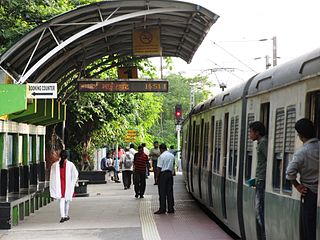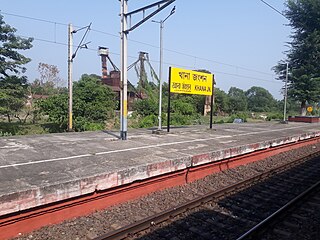
Sealdah Railway Station is one of India's major railway terminals serving the city of Kolkata. The other main railway stations in the Kolkata metropolitan area are Howrah, Shalimar, Kolkata and Santragachi. Over 1.5 million passengers use the station daily. It is an important suburban rail terminal. Kolkata Metro Line 2 passes through Sealdah with the new underground Sealdah metro station.

The Kolkata Suburban Railway is a set of suburban and regional rail services serving the Kolkata metropolitan area and its surroundings in India. It is the largest suburban railway network in the country by number of stations and track length, and also one of the largest in the world. There are five main lines and nineteen branch lines. It operates more than 1,500 services, carrying 3.5 million people daily and 1.2 billion people every year. It runs from 03:00 am until 02:00 am and fares range from Rs.5 to Rs.25. The system uses 25 kV 50 Hz AC power supply and runs on 5 ft 6 in broad gauge track. It has interchange stations with the Kolkata Metro at various locations.

Asansol Junction is a railway station of Eastern Railway in Asansol of Paschim Bardhaman district in the Indian state of West Bengal. The station is on the Howrah–Delhi main line. It is the 8th busiest railway station in India in terms of frequency of trains after Kanpur Central, Vijayawada Junction, Delhi Junction, New Delhi, Ambala Cant, Howrah and Patna Junction. Around 171 trains pass through the station daily. It serves Asansol and the surrounding areas.

The Howrah–New Delhi main line is a railway line connecting Delhi and Kolkata cutting across northern India. The 1,531 km (951 mi) railway line was opened to traffic in 1866 with the introduction of the "1 Down/2 Up Mail" train.

The Sahibganj loop is a railway line connecting Khana Junction and Kiul Junction. Originally a part of the Howrah–Delhi main line, it was opened to traffic in 1866. With the construction of a shorter railway line for a part of the route, the 403.8 kilometres (250.9 mi) stretch was assigned a separate identity.

The Howrah–Barddhaman main line is a broad-gauge railway line connecting Howrah and Barddhaman via Bandel. The 107 kilometres (66 mi) railway line operates in Howrah, Hooghly and Purba Barddhaman districts in the Indian state of West Bengal. It is part of the Howrah–Delhi main line and the Kolkata Suburban Railway system.
The Howrah–Bardhaman chord is a broad-gauge rail line connecting Howrah and Bardhaman. The 95-kilometre-long (59 mi) railway line operates in Howrah, Hooghly and Purba Bardhaman districts in the state of West Bengal. It is part of the Howrah–Gaya–Delhi line,Howrah–Delhi main line,Howrah–Prayagraj–Mumbai line and the Kolkata Suburban Railway system.

The Bardhaman–Asansol section is a railway line connecting Bardhaman and Asansol. This 106 kilometres (66 mi) track is part of the Howrah–Delhi main line, Howrah–Gaya–Delhi line and Howrah–Allahabad–Mumbai line. It is under the jurisdiction of Eastern Railway, and is connected to the South Eastern Railway through Asansol–Adra line at Asansol Jn and Kalipahari–Damodar connector at Kalipahari.

Barharwa Junction is a railway station on the Sahibganj loop and is located at Barharwa in Sahibganj District in the Indian state of Jharkhand.

The Barharwa–Azimganj–Katwa loop is a railway line connecting Barharwa on the Sahibganj loop and Katwa. Together with the Bandel–Katwa line, which connects this line to Bandel Junction on the Howrah–Bardhaman main line, it is also known as the B.B Loop Line. This 170 kilometres (110 mi) line is under the jurisdiction of Eastern Railway. The majority of this line passes through the Purba Bardhaman and Murshidabad districts, in the Indian state of West Bengal, and lies on the west bank of the Bhagirathi river.

The Howrah–New Jalpaiguri line is a railway line connecting Howrah with New Jalpaiguri in North Bengal in the Indian state of West Bengal. The line continues through North Bengal and western part of Assam to connect with Guwahati. The Naihati–Bandel link allows trains from another terminus Sealdah in Calcutta to use this route. The line uses a major part of the Barharwa–Azimganj–Katwa loop. Many trains use an alternative line between Howrah and New Farakka, via Bardhaman and Rampurhat. Other parts of West Bengal and Bihar are well-connected to this line. It is under the administrative jurisdiction of Eastern Railway and Northeast Frontier Railway.

The Sealdah–Ranaghat–Gede line connects the Sealdah Main and North terminus of Kolkata with Ranaghat and Gede of Nadia district of West Bengal, India. Once a part of the old Calcutta–Siliguri main line, today it is a busy suburban section of the Kolkata Suburban Railway's Sealdah North section connecting the North 24 Parganas and Nadia districts with Kolkata. It is under the jurisdiction of the Sealdah railway division of the Eastern Railway zone of the Indian Railways.

The Ranaghat–Krishnanagar City–Lalgola line is a 155 km (96 mi) long broad gauge railway line which connects Ranaghat Junction in the Nadia district with Lalgola in the Murshidabad district of the Indian state of West Bengal. The line runs up to the Bangladesh border near the Ganga river and is a part of the Sealdah railway division of the Eastern Railway zone.

The Howrah–Gaya–Delhi is a railway line connecting Howrah and Delhi cutting across Indo-Gangetic Plain and a comparatively small stretch of the line crossing over the Chota Nagpur Plateau. It covers a distance of 1,452 kilometres (902 mi) across, West Bengal, Jharkhand, Bihar, Uttar Pradesh and Delhi. The Grand Chord is a part of this line and as such is referred to by many as Howrah–Delhi line.
The Eastern line of Kolkata Suburban Railway is a public transit system serving Kolkata, West Bengal, India. It consists of total 266 stations from Howrah Junction to Barddhaman & Sealdah to Gede. The entire line is at grade. It has two sections of quadruple tracks, First section is starting from Howrah Junction and ends at Barddhaman, Katwa, Goghat, Bandel and second section is starting from Sealdah and ends at Hasnabad, Bangaon, Gede, Krishnanagar, Lalgola, Ranaghat & Naihati stations in West Bengal.

The Sealdah–Bangaon line is a 78 km (48 mi) long broad gauge railway line that connects the Sealdah Main and North terminus of Kolkata with Bangaon of North 24 Parganas district of West Bengal, India. Once a part of the old Calcutta–Jessore–Khulna line, today it is a busy suburban section of the Kolkata Suburban Railway's Sealdah North section. It is under the jurisdiction of the Sealdah railway division of the Eastern Railway zone of the Indian Railways.
Salar railway station is a railway station on the Howrah–Azimganj line of Howrah railway division of Eastern Railway zone. It is situated at Salar, Murshidabad in the Indian state of West Bengal.

Ahmadpur Junction railway station is an important junction railway station under Howrah railway division of Eastern Railway zone. It is the connecting station of Sahibganj loop line and Ahmadpur–Katwa line. It is situated beside Suri road at Ahmedpur in Birbhum district in the Indian state of West Bengal. Total 46 Express and passengers trains stop at Ahmadpur Junction railway station.

Guskara railway station is a railway station of Sahibganj loop line under Howrah railway division of Eastern Railway zone. It is situated beside Guskara–Dignagar Road at Guskara in Purba Bardhaman district in the Indian state of West Bengal. Toatal 40 express and passenger trains stop at Guskara railway station. It is a NSG-5 category rail station.

The Sealdah Main and North section refer to a set of rail lines which connect the city of Kolkata with its northern suburbs and with the North 24 Parganas, Nadia and Murshidabad districts of West Bengal, India along the eastern bank of the Hooghly river. It is a part of the Kolkata Suburban Railway and is under the jurisdiction of the Sealdah railway division of the Eastern Railway zone of Indian Railways.




















